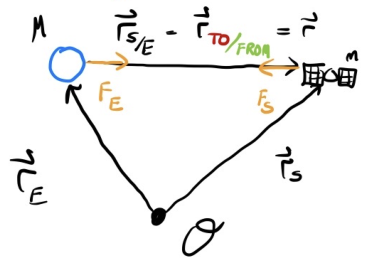Kepler
- Planet orbits follow an Ellipse
- Motion of planets carve out equal area in ellipses per unit time
- for fixed
- Period of motion is related to semi-major axis (SMA)
- Geometric Solution to 2BP
Newton
Creates Calculus
- Builds derivatives off of ratios:
- Computes forces:
- Compute acceleration:
- Subtract accelerations to find relative motion:
- Assume :
Validating K2
- Using the triangle small angle approximation:
- Area of triangle:
- If Kepler’s second law holds, then will be
- , and thus angular momentum does not change
Move from 2D to 3D
- Define Polar Bases using Cartesian Basis Vectors
- Define position, , and velocity, , in polar coordinates
- Compute magnitude of
Validating K1
- Put and together
Quick sidebar for some questions
What do we know about ?
- Constant of motion
- In the plane of motion
What don’t we know about ?
- Where is it pointing?
- Is there a meaningful geometric analog?
Where is wrt. ?
This gives:
- Newton’s “Calculus” thing might actually work!
-
Compare physical quantities with geometric:
-
Tie up loose ends by defining eccentricity vector:
- Upon inspection of the ellipse image, lies on the semi-major axis and points to periapsis
- Like with , we want to know about
Using this information
Vis-Viva Equation
- Means that if we know position on the elliptical orbit, we immediately know the velocity (and vice-versa)
- We can simplify beyond to only need
Prediction
Motivation
- Newton wasn’t happy with being able to describe the motion, he wanted to predict the motion
- Want:
- This way, we can know where the planets will be at some in the future
Creating the prediction model
- Oh my! That doesn’t look fun to integrate (especially if you just invented calculus and are the only one on the planet who knows integration)
- Let’s think:
- Question: Is there a more integration-friendly way to represent/model this motion?
- Answer: Yes! Let’s use the eccentric anomaly of the ellipse
- Let’s rederive using Eccentric Anomaly
- Plug into
- This leads directly into Kepler’s Equation
